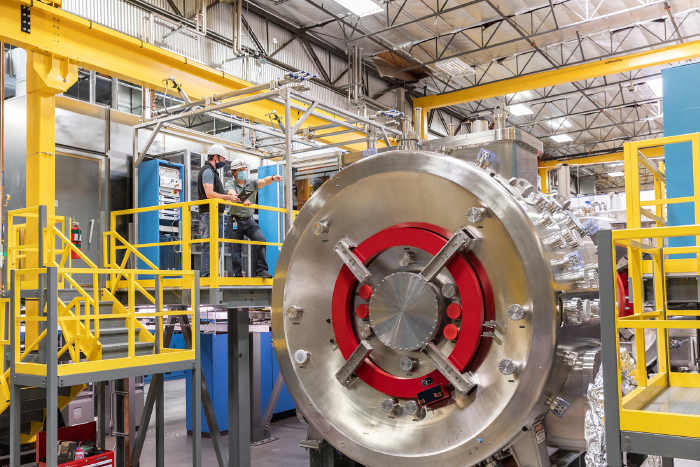California Gov. Gavin Newsom signed landmark legislation, Assembly Bill 1172, on October 7, 2023. Authored by State Assemblymember Lisa Calderon (D-Whittier) and spearheaded in the Senate by Senator Josh Newman (D-Fullerton), the bill supports California’s fusion energy industry by recognizing this cutting-edge technology’s safety and environmental benefits while setting the stage for the state’s future regulatory framework. Home to innovators and fusion pioneer TAE Technologies, the bill’s signing makes California the first U.S. state to enshrine in law the fundamental distinction between fusion energy and traditional nuclear fission. AB1172 also recognizes the diversity of scientific approaches to achieving fusion’s transformative potential for the California grid for the first time.
“Fusion energy can advance California’s progress towards its statutory renewable energy and climate mandates. Fusion energy development presents an opportunity to further promote California’s workforce development within the renewable energy sector,” the legislation states.
As the nation’s first private company to pursue the commercialization of fusion energy, Southern California-based TAE Technologies applauds this legislation’s passage (with unanimous support in both chambers), not only for its recognition of fusion energy’s potential contributions to providing clean energy, but for recognizing that this groundbreaking industry requires bespoke regulation. Just as fusion and fission rely on opposite reactions—where fusion combines atoms, fission splits them—there are fundamental differences in how these nuclear technologies need to be regulated, and California’s lawmakers are addressing those needs for the first time. Fusion is inherently safe and deserves a well-considered regulatory path that allows fusion to be developed safely and expediently.
“With this bill’s passage, California’s governor and legislators are recognizing the vast potential of commercial fusion energy to be a part of a clean energy solution that brings carbon-free energy, jobs and a much-needed innovation to our state, and to our world,” said TAE Technologies CEO Michl Binderbauer.
The legislation follows the recent net energy achievement of the Lawrence Livermore National Laboratory in California, and reflects a global race to harness the power of fusion for commercial use. Assembly Bill 1172 requires the California Energy Commission to identify all needed regulatory and policy actions to incorporate fusion into the state’s energy system. AB1172 also defines fusion energy in California law for the first time, helping ensure that California can ensure the highest standards of safety and public trust while differentiating it from unrelated technologies like traditional nuclear fission. Notably, fusion, unlike fission, doesn’t produce long-lived radioactive waste and with fusion energy, nuclear meltdown is impossible.
On the occasion of the signing, Assemblymember Lisa Calderon said: “California must continue to invest in clean, renewable sources of energy to meet our climate goals. There has been significant progress from the fusion industry, with companies now on the path to creating commercially viable systems that can safely generate clean energy for cities. This law will help California safely integrate fusion energy technology as a renewable energy source.”
State Senator Josh Newman said: “Last year, I had the privilege of joining a delegation of state and federal legislators for a tour of TAE’s facilities to learn more about the world-class, innovative research and development on sustainable fusion and spin-off technologies underway right here in Orange County. The progress and promise of TAE’s work on commercial fusion is in line with California’s stature as a global leader in research and innovation and offers tremendous promise, not only for California’s future clean energy prospects but for the creation of thousands of vital, high-skilled jobs as well.”
TAE Technologies is the global leader in commercial development of aneutronic fusion power, an advanced form of fusion that does not produce neutrons in its primary reaction and has several key benefits, including no radioactive waste and longer-life devices that result in lower energy prices for producers and consumers. The new law specifically requires the California Energy Commission to define and examine this distinctive, impact-forward form of fusion for the first time.
Fusion also complements renewables, because it is a zero-emission energy source that is consistently available throughout the day and seasons, regardless of the weather or sunshine. By comparison to any other source of renewable or clean energy, fusion has substantially greater power density, requires little fuel, and has minimal environmental impact.
“Controlled thermonuclear fusion is one of the very few long term, environmentally friendly and inherently safe options,” the International Atomic Energy Agency wrote in a report last month, adding “In principle, fusion could generate four times more energy per kilogram of fuel than fission and nearly four million times more energy than burning oil and coal.”
TAE is developing aneutronic fusion that will rely on hydrogen-boron (also known as proton-boron or p-B11) fuel, which is safe, abundant, non-radioactive and inexpensive. Slated to enter the marketplace in the early 2030s, TAE’s planned commercial hydrogen-boron fusion energy plants will play a key role in meeting Gov. Newsom’s ambitious plan to power California with 100% clean energy by 2045. At the federal level, the Nuclear Regulatory Commission is drafting new regulations defining fusion. At every level and around the globe, leaders are recognizing the safety benefits of fusion and are drafting rules and recommendations on how to regulate it with a lighter touch than other forms of nuclear energy.
As regulations develop, TAE is hard at work creating the fusion energy machines that will power the future. Earlier this year, TAE broke ground at a new 100,000 square foot facility in Irvine, CA, to house its next fusion research machine, Copernicus, which is expected to demonstrate the viability of net energy generation from TAE’s proprietary configuration around the mid-2020s. With that milestone in hand, TAE will develop its first prototype hydrogen-boron fusion power plant, Da Vinci, to deliver electricity to the grid in the early 2030s.

COMMENTS